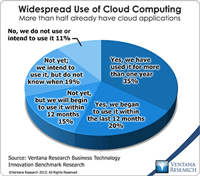
There’s a growing realization that the multitenant approach to the cloud isn’t the only option that companies should weigh in deciding between deploying software on-premises and in the cloud. That some people describe the multitenancy approach as “the real cloud” reflects the contentious nature of some technical debates, especially those that occur early in the evolution of a new technology. Multitenancy does have advantages that confer cost savings, and these have been important in the first...
Topics: Microsoft, Mobile, SaaS, Sales, Salesforce.com, ERP, HCM, Human Capital, Office of Finance, Planview, Concur, Dynamics AX, Dynamics GP, Dynamics NAV Dynamics SL, PSA, Sage Software, Unit4, Analytics, Cloud Computing, Business Performance Management (BPM), CFO, Financial Performance Management (FPM), FinancialForce, HR, Infor, Tagetik, Workday, Workforce Performance Management (WPM), Plex









